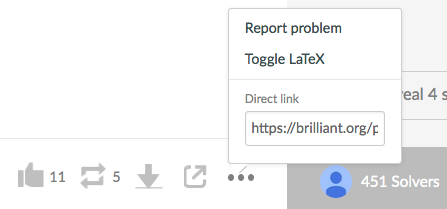limit
x → 0 lim x 2 ( 1 + x ) x 1 − e + 2 1 e x
Find the value of the limit above.
The answer is 1.246.
This section requires Javascript.
You are seeing this because something didn't load right. We suggest you, (a) try
refreshing the page, (b) enabling javascript if it is disabled on your browser and,
finally, (c)
loading the
non-javascript version of this page
. We're sorry about the hassle.
4 solutions
If f is twice differentiable near 0 , then by applying L'Hospital's rule twice, x → 0 lim x 2 e f ( x ) − ( 1 + f ′ ( 0 ) x ) e f ( 0 ) = x → 0 lim 2 x f ′ ( x ) e f ( x ) − f ′ ( 0 ) e f ( 0 ) = x → 0 lim 2 ( f ′ ′ ( x ) + f ′ ( x ) 2 ) e f ( x ) = 2 f ′ ′ ( 0 ) + f ′ ( 0 ) 2 e f ( 0 ) . Now plug f ( x ) = x lo g ( 1 + x ) = 1 − 2 1 x + 3 1 x 2 + ⋯ , so that f ( 0 ) = 1 , f ′ ( 0 ) = − 2 1 , and f ′ ′ ( 0 ) = 3 2 . Then this limit becomes x → 0 lim x 2 ( 1 + x ) 1 / x − e + 2 x e = 2 4 1 1 e .
The answer is not 0.458.Answer is 1.246. (1+x)^{1/x}=e[1-x/2+11x^{2}/24 . . . .]
Thanks. I have updated the answer accordingly. Can you edit your solution and explain how you arrived at the result?
In future, if you spot any errors with a problem, you can “report” it by selecting "report problem" in the “dot dot dot” menu in the lower right corner. This will notify the problem creator who can fix it the issues.

use expansion of ( 1 + x ) ( 1 / x ) = e ( 1 − ( x / 2 ) + ( 1 1 x ( 2 ) ) / 2 4 . . . .
L = x → 0 lim x 2 ( 1 + x ) x 1 − e + 2 1 e x = x → 0 lim 2 x ( x ( 1 + x ) 1 − x 2 ln ( 1 + x ) ) ( 1 + x ) x 1 + 2 1 e = x → 0 lim 2 x ( x 1 ( 1 − x + x 2 − ⋯ ) − x 2 1 ( x − 2 x 2 + 3 x 3 − ⋯ ) ) ( 1 + x ) x 1 + 2 1 e = x → 0 lim 2 x ( − 2 1 + 3 2 x − 4 3 x 2 + ⋯ ) ( 1 + x ) x 1 + 2 1 e = x → 0 lim 2 ( 3 2 − 2 3 x + 5 1 2 x 2 − ⋯ ) ( 1 + x ) x 1 + ( x ( 1 + x ) 1 − x 2 ln ( 1 + x ) ) 2 ( 1 + x ) x 1 = 2 3 2 e + 4 1 e = 2 4 1 1 e ≈ 1 . 2 4 6 A 0/0 case, L’H o ˆ pital’s rule applies Differentiate up and down w.r.t. x Using Maclaurin series A 0/0 case again Differentiate up and down w.r.t. x
References: